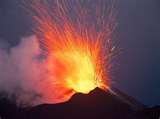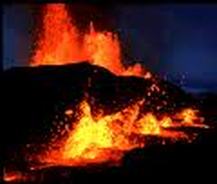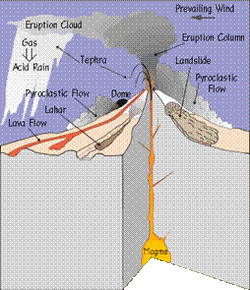Volcanoes!
What Affects Eruptions

Magma composition, magma temperature, and the amount of dissolved gases in the magma determine whether a volcano erupts violently or quietly.
Viscosity- a substance's resistance to flow.
Ex: Maple syrup is more viscous than water and flows more slowly.
Dissolved Gases
During explosive eruptions, the gases trapped in magma provide the force to eject molten rock from the vent-opening to the surface.The gases are mostly water vacpor and carbon dioxide. As magma rises to the surface the pressure is greatly reduced. The reduced pressure causes the gases to release suddenly.
Viscosity- a substance's resistance to flow.
Ex: Maple syrup is more viscous than water and flows more slowly.
Dissolved Gases
During explosive eruptions, the gases trapped in magma provide the force to eject molten rock from the vent-opening to the surface.The gases are mostly water vacpor and carbon dioxide. As magma rises to the surface the pressure is greatly reduced. The reduced pressure causes the gases to release suddenly.
Volcanic Material

Lava Flows
Hot basaltic lavas are usually very fluid because of their low silica content. The rate of flow can be from 10 to 100 meters per hour.
Gases
Magma contains varied amounts of gases held in the rock by confining pressure.
Ex: When carbon dioxide is held in soft drinks. As soon as the pressure is reduced the gases begin to escape.
Pyroclastic Material
When basaltic lava is extruded, dissolved gases propel blobs of lava to great heights.Pyroclastic material is the name given to particles produced in volcanic eruptions.
Hot basaltic lavas are usually very fluid because of their low silica content. The rate of flow can be from 10 to 100 meters per hour.
Gases
Magma contains varied amounts of gases held in the rock by confining pressure.
Ex: When carbon dioxide is held in soft drinks. As soon as the pressure is reduced the gases begin to escape.
Pyroclastic Material
When basaltic lava is extruded, dissolved gases propel blobs of lava to great heights.Pyroclastic material is the name given to particles produced in volcanic eruptions.
Anatomy of a Volcano

The three main volcanic types are shield volcanoes, cinder cones, and composite cones. Volcanic activity begins with a crack,develops in the crust as the magma is forced to the surface. The magma moves up this fissure, through a circular pipe, ending at a vent. Repeated eruptions usually form a volcano.A steep-walled depression (crator) is located at the summit of many volcanoes.
Shield Volcanoes
Shield Volcanoes are produced by the accumulation of fluid basaltic lavas. Shield volcanoes have the shape of a broad, slightly domed structure that resembles a warrior’s shield. Most shield volcanoes have grown up from the deep-ocean floor to form islands.
Cinder Cones
Cinder Cone- formed by ejected lava fragments the size of cinders which harden in the air. Cinder cones are usally produced from relatively gas-rich basaltic magma.
Composite Cones
Composite Cone- large, symmetrical structure composed of layers of both lava and pyroclastic deposit. They are the product of gas-rich magma having an andestic composition. They also generate the most explosive eruptions that eject huge quantities of pyroclastic material.
Shield Volcanoes
Shield Volcanoes are produced by the accumulation of fluid basaltic lavas. Shield volcanoes have the shape of a broad, slightly domed structure that resembles a warrior’s shield. Most shield volcanoes have grown up from the deep-ocean floor to form islands.
Cinder Cones
Cinder Cone- formed by ejected lava fragments the size of cinders which harden in the air. Cinder cones are usally produced from relatively gas-rich basaltic magma.
Composite Cones
Composite Cone- large, symmetrical structure composed of layers of both lava and pyroclastic deposit. They are the product of gas-rich magma having an andestic composition. They also generate the most explosive eruptions that eject huge quantities of pyroclastic material.
